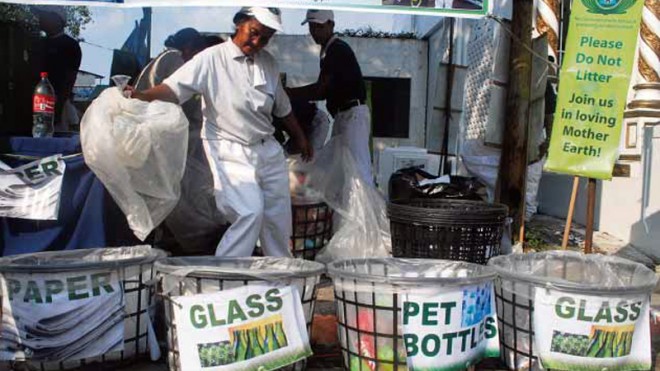
A volunteer of the Tzu Chi Foundation mans a waste segregation site at Manila South Cemetery on All Saints’ Day. ARNOLD ALMACEN
MANILA, Philippines–Much to the dismay of environmentalists, Filipinos apparently still lack “cemetiquette,” or cemetery etiquette, in terms of public cleanliness, as this year’s All Saints’ Day trash collected in graveyards in Metro Manila was double the volume collected last year.
Only four cemeteries were cited for “good practices,” but only because officials prohibited plastic “fiesta” buntings and signs or posters nailed on trees, and also required people to clean up their own spaces before leaving.
“We mourn the apparent disregard for the dead of many who visited their departed loved ones, as (cemeteries were again) strewn with litter on ‘Undas,’” EcoWaste Coalition Zero Waste program officer Christina Vergara said in a statement Sunday.
Days before the holiday, EcoWaste—a coalition composed of more than 150 environment and health groups nationwide—campaigned for so-called cemetiquette or a set of basic reminders for people flocking to cemeteries to dispose of their trash properly.
But the group found that their efforts came to naught when its volunteers initiated cleanup operations on Sunday, particularly at the Manila North Cemetery, and still found a large volume of food wastes, discarded packaging, plastic bags, barbecue sticks, cigarette butts, etc., dumped on the grave sites.
“The garbage before us [was] a living testament to the rampant disregard (for) the Ecological Solid Waste Management Act of 2000, or Republic Act 9003, which explicitly prohibits littering, open dumping, and open burning of garbage in public places,” Vergara added.
Room for improvement
But EcoWaste commended the officials of three major cemeteries in Metro Manila and one in Rizal province.
Though still cited for the trash left by the grave site visitors, both Manila North and South cemeteries did away with the usual plastic buntings on its streets and alleys, which for years had only added to the clutter and post-Undas mess.
The management of Manila Memorial Park (MMP) in Parañaque City disallowed ads and signs nailed on trees, while officials of Angono Municipal Cemetery strictly implemented its “Basura Mo, Iuwi Mo (Take your own trash home)” policy.
An open trash heap left on All Saints’ Day by Manila South Cemetery visitors who paid no mind to the EcoWaste Coalition’s environmental campaign. ARNOLD ALMACEN
“We commend the administration of these cemeteries for addressing (the problem of) solid waste and instituting environmental protection measures in their areas of concern; but then again, we see more room for improvement next year,” Vergara said.
MMDA haul; recycling booths
The Metropolitan Manila Development Authority (MMDA) said it had hauled off a total of 139 truckloads, or 834 tons, of garbage as of Sunday from 21 major cemeteries in the capital, twice the volume of trash collected last year.
The volume is still expected to rise as cleanup operations at cemeteries continue until Tuesday, according to Francis Martinez, head of the MMDA Parkway Clearing Group.
Meanwhile, hoping to make a dent on the recurring environmental concern, the Buddhist organization Tzu Chi Foundation had set up recycling booths at Manila North and South, Loyola Memorial Park and Manila Memorial Park.
Garbage collected at these booths will be sorted at the Tzu Chi center in Sta. Mesa, Manila, according to head volunteer Siony de Guzman.
“The plastic bottles, for example, will be shipped to Taiwan and will be turned into thermal blankets which will be distributed to calamity victims in the country,” De Guzman said, adding that 80 plastic bottles are needed to make one blanket.–With a report from Maricar B. Brizuela
RELATED STORIES
‘Cemetiquette’: Do’s, don’t’s on Nov. 1 and 2
Prelate, environmental watchdog: Don’t turn cemeteries into ‘huge garbage bins’